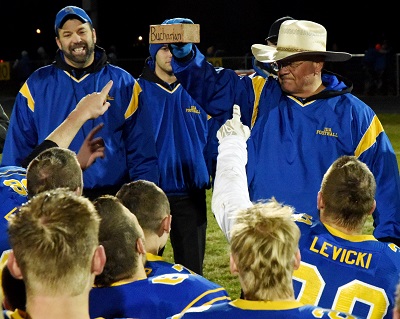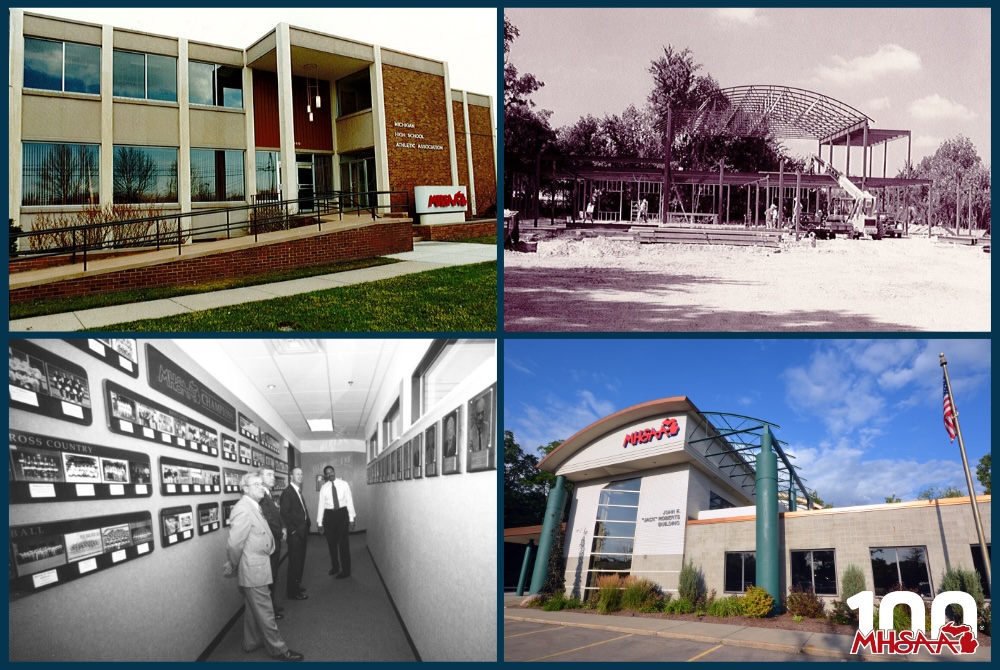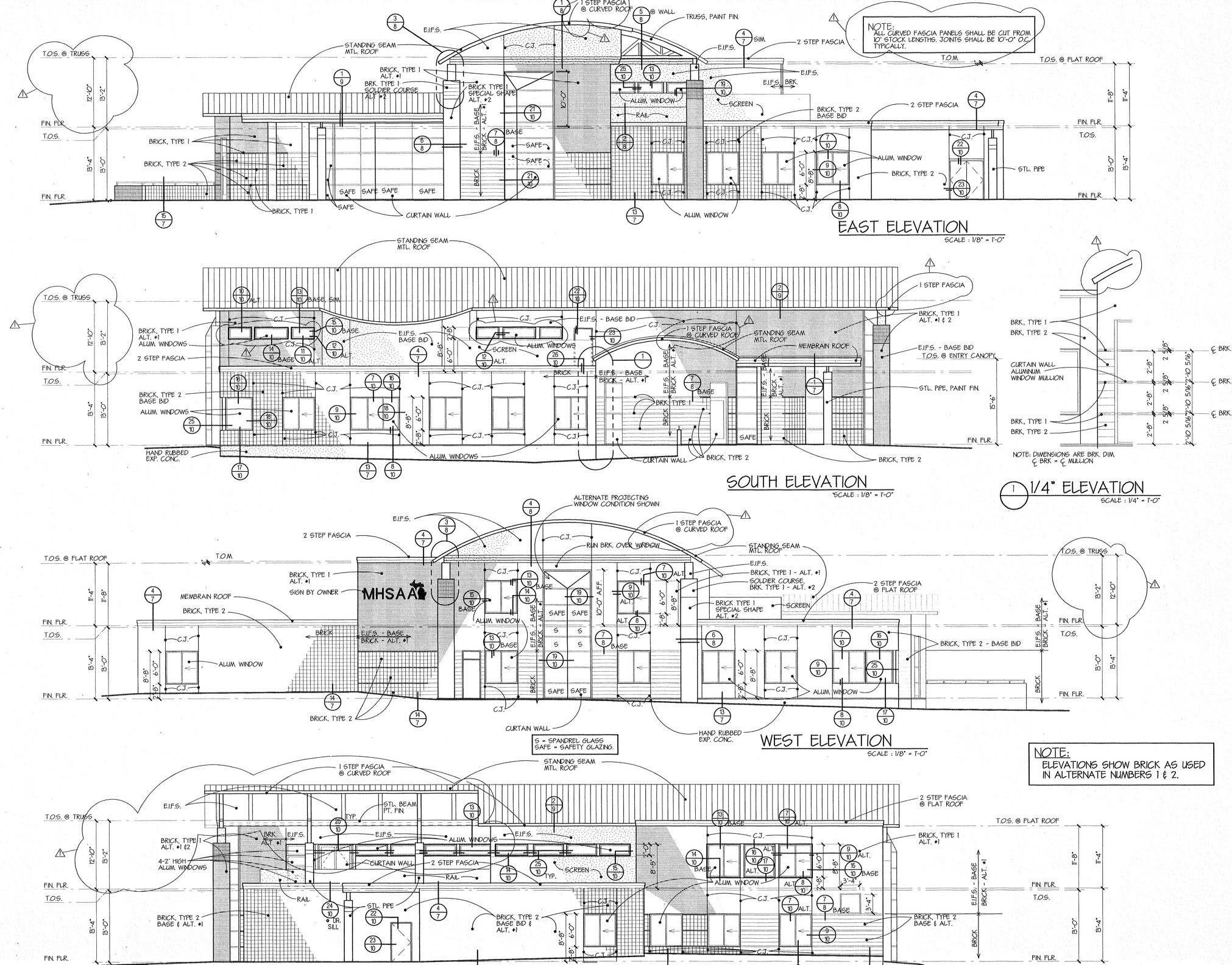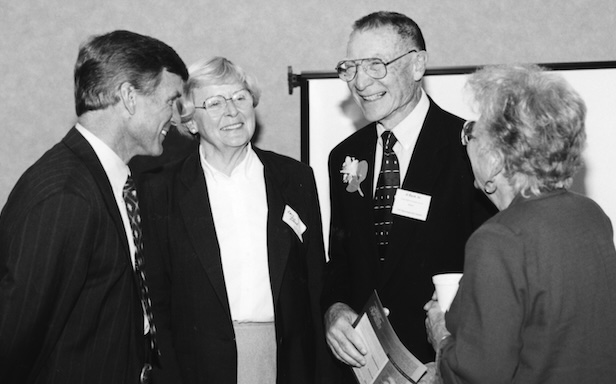
Jackson Area Efforts Net New Officials
February 16, 2016
By Geoff Kimmerly
Second Half editor
Recruitment of new high school officials to eventually take the reins from those currently conducting MHSAA events is a challenge faced all over Michigan.
 The Jackson Area Officials Association is working to restock its ranks by recruiting directly from local schools and developing them with help from veteran mentors.
The Jackson Area Officials Association is working to restock its ranks by recruiting directly from local schools and developing them with help from veteran mentors.
Eight new officials – ages 15 to 24 – who worked a series of youth and middle school games together earlier this month, are among those who have been introduced through a program that begins with a meeting at the end of the high school basketball season between JAOA official Bill Walker and local athletic directors, coaches, fellow officials and other young adults he’s made contact with over the course of a season. From that meeting, Walker builds a list of potential candidates to become officials and then invites them to the annual JAOA Legacy Camp in June.
The camp includes two days of scrimmages between local teams, plus classroom and mechanics teaching. Similar to the MHSAA Legacy program, new officials are paired with veterans, and clinicians evaluate their work during scrimmage play. Walker then keeps in touch with the new officials during the rest of the summer, plugging them in for local youth tournaments and scrimmages, and uses as many as possible while assigning officials for youth tournaments over the winter.
All eight officials who worked the event this month are part of the JAOA legacy partnering, and some of the group already are working games at the junior varsity level – with one, a 19-year-old, recently completing his first varsity game. They come from a variety of Jackson-area schools – Parma Western, Napoleon, Jackson Christian, Michigan Center, Concord and East Jackson. Walker said the recruiting effort has a 60 percent success rate so far. (This June’s legacy camp will be the third.)
“By next season, all (eight) will be official MHSAA registered officials,” he said, noting most currently are registered. “It’s great to have these schools support this program. We all benefit from added, good officiating.”
Passing it forward
Our Battle of the Fans trip to Charlotte on Friday included a conversation about a Feb. 2 game between the Orioles and Mason, which has a pair of athletes fighting cancer. The Charlotte student section dressed in blue that night in support of junior Storm Miller, and during halftime passed buckets to raise money for Miller’s GoFundMe account set up to help pay for his care.
Mason, in turn, provided support Friday to an Owosso alum, 2012 graduate Cody Greger, who remains hospitalized at University of Michigan’s hospital with injuries sustained during a house fire in November. Fans and students collected donations to assist Greger’s family with his care.
“This event was yet another example of the values that school sports teach young people,” Owosso athletic director Dallas Lintner wrote on the school’s website. “And it stands as a testament of the integrity of the young adults that represent our schools and the (Capital Area Activities Conference.)."
100 years of hoops
A decade before the formation of the Michigan High School Athletic Association, Eastern Michigan University – then known as Michigan State Normal College – hosted what is believed to be the first organized high school basketball tournament in state history.
EMU will celebrate this anniversary Saturday in conjunction with the Eagles men’s basketball game against Toledo. Game time is noon at EMU’s Convocation Center, and during a break in play the athletic department will recognize the 12 schools that took part in that 1916 tournament – Marine City, Dundee, Milan, Mancelona, Farmington, Elkton, Royal Oak, Middleville, Lansing, Mount Clemens, Wayne and Saline.
More history, courtesy of EMU:
The game of basketball was developed by James Naismith in 1891 at Springfield College in Massachusetts. As a means of promoting the game throughout the country, physical education professor and EMU's first athletic director Wilber Bowen asked his good friend Naismith to bring the game to the Michigan State Normal College (now known as Eastern Michigan University).
The first basketball game west of the Allegheny Mountains was played at Michigan Normal in 1894 to recognize the new physical education program and to dedicate the new gymnasium on campus.
Then in 1916, Bowen, along with instructors Elmer Mitchell and Lloyd Olds (who was also credited with the introduction of the striped referee jersey), organized the first high school basketball tournament in Michigan. A total of 300 invitations were sent out to all Class B schools in the state. Twelve schools responded, and the first high school boys tournament was held on the Ypsilanti-based campus on March 23-25, 1916.
Entrance to the tournament was free and (the event was) played at the Michigan State Normal School Gymnasium. However, expenses related to transportation, room, and board had to be provided by the participating schools. The MSNC's Physical Education Department made it easier for schools to participate by making arrangements with local residents to provide food at 20 to 25 cents a meal and lodging at 25 cents a night for each player.
That first tournament saw Marine City defeat Dundee in the championship game, 23-22.
The winning team was awarded a silver shield mounted on an oak base. Second prize was a silver cup, and the third place team received a banner. Individual participation awards to all players were also provided. The Ypsilanti Press at the time felt the Normal School "went first class with the awards."
For tickets to Saturday’s game and event, which will be followed by the EMU women’s team taking on Northern Illinois, call the EMU Ticket Office at (734) 487-2282 or visit EMUEagles.com/tickets.
Following up
 • Second Half’s Chip Mundy this fall wrote a story on the emergence of Ida’s football team on the way to making the Division 5 Semifinals and finishing its best season ever. A theme of that story was Ida’s philosophy of building “brick by brick,” coined by defensive line coach Gary Deland, who himself was building back after emergency triple-bypass heart surgery.
• Second Half’s Chip Mundy this fall wrote a story on the emergence of Ida’s football team on the way to making the Division 5 Semifinals and finishing its best season ever. A theme of that story was Ida’s philosophy of building “brick by brick,” coined by defensive line coach Gary Deland, who himself was building back after emergency triple-bypass heart surgery.
“From that very first practice in the summer to the last game as a senior, everything is built brick by brick,” Deland said for that story. “I can draw a correlation between that and my recovery, what I’ve gone through. It’s the same thing. It’s brick by brick.”
Kim Farver sent along this photo of Deland holding up a brick after the team’s 43-20 Regional Final win over Buchanan.
• We released the last batch of this year’s MHSAA-Farm Bureau Insurance Scholar-Athlete Award winners today, and one of the highlights during the 27 years of the contest came two years ago when we caught up with some of our winners from the first 25 years – including Bloomfield Hills Cranbrook-Kingswood’s Abby Cohen, who has gone on to co-found a company and help develop a smartphone application, Wing, to help asthma patients monitor their lung function.
Here’s a look at a video describing the technology she’s helped create:

Century of School Sports: MHSAA's Home Sweet Home
By
Rob Kaminski
MHSAA benchmarks editor
November 5, 2024
Visitors to 1661 Ramblewood Drive for the multitude of MHSAA committee meetings, in-services and other functions are sure to see the faces of Michigan’s renowned educational athletics leaders throughout the years on various recognition boards.
Absent from any of those displays is the late East Lansing resident Thomas Reck. Yet, Reck and the long-range vision of Jack Roberts were equally as vital in “restructuring” the MHSAA in the late 1990s; quite physically.
“I really wanted something along US-127 – visible from 127 – and there was a good deal of open land where the building sits now that looked to be about the right size,” recalled Roberts, who at the time was just finishing the first decade of what would be an iconic 32-year run as the executive director of the MHSAA.
There was one potential roadblock to Roberts’ dream location: There was no indication of any kind that the property was for sale; no billboard, no realty listing.
That’s because it wasn’t for sale – yet.
“I contacted a realtor, Martin Property Development, and I suggested one of their employees call upon Mr. Reck,” Roberts said. “He did that, and got a purchase price of $600,000. To me, the excitement really took place before the first shovel went into the ground.”
The deal was then approved by both parties, and development began in 1996, with Reck’s residence remaining in place atop the small hill south of the new road leading to the proposed site of the MHSAA building.
“When we bought the land, there was no road,” Roberts said. “One of the reasons it curves is that Mr. Reck was given a life lease, so we had to go around his house. It also had to navigate some protected wetland areas.”
As for the name of the road, that was the MHSAA’s choice, one which actually came quite easily. The city of East Lansing had some concerns with the new development, and expanding on an existing name for the road was the first show of good faith by the newest tenants. Keeping the name Ramblewood made sense as there was already a Ramblewood Drive at the exact intersection to the east of Coolidge Road.
“We didn’t want to come in and change a lot of things, or inconvenience the residents in that area,” Roberts said. “We kept development back from the road and kept as much nature intact as possible. Even the signs that are there now are off the road and relatively small.”
Roberts and staff needed no signs to find their way to the new digs just more than three miles north of the previous offices on Trowbridge Road.
 Led by Roberts and former assistant director Tom Minter, much of the moving occurred during Christmas break of 1996. Doors to the new building were opened in January 1997, roughly seven years after Roberts first began dreaming of a new home.
Led by Roberts and former assistant director Tom Minter, much of the moving occurred during Christmas break of 1996. Doors to the new building were opened in January 1997, roughly seven years after Roberts first began dreaming of a new home.
The building on Trowbridge was formerly a credit union, and its structure provided some unique problems.
“In the late 1980s, around ‘88 or ‘89, we bought our first major computer, an IBM mainframe, and put it upstairs in the old building,” Roberts said. “It was about five feet high and eight feet wide and had its own room. We had to drill through concrete to wire it. I began to realize that we were going to have a hard time keeping up with things in a building that was so difficult to modernize.”
John Johnson, the MHSAA’s first communications director and a pioneer in that position among state high school associations, also reflected on the early days.
“Anything which was data-driven was jobbed out for awhile,” Johnson said. “Football playoff rankings were delivered to us once a week from a third party. We were doing everything outside the building: school databases, officials databases, penalty databases. The only thing we had inside the walls was word processing. I had the first PC in 1987.”
And, he recalled, the beast of a mainframe that took up an entire room at the expense of personnel. “Yep, it took up the whole room,” Johnson confirmed. “I was in what was called the library, which had historical books, but also old T-shirts left over from previous years’ champions.”
That lack of storage was also motivation for Roberts to find new real estate, and addressing that shortcoming was paramount in the plans.
“We had no storage, and no efficient way to receive shipments like rules books, paper, and the basic supplies we needed to run our business,” Roberts said. “That’s also why we have the lift in its current location at the new building; shipping and receiving were really important to us, along with our drop ceiling which made it much easier to run wiring as needed.”
As sparkling and expansive as the new facilities were, perhaps the best feature of all was its cost. The structure only took up a portion of the land purchased by the association, per Roberts’ vision. That left four parcels on the property for sale by the MHSAA, and with the road and utilities in place, those sections became even more valuable and enticing.
The MHSAA’s expenditures totaled roughly $1 million for the purchase of the land, road construction and utility installations. The parcels then sold for approximately $300,000 apiece.
“In the end, we had our space free of charge, and had $200,000 for furnishings,” Roberts said. The lone cost would then be the actual construction of the building, financed through a bond. And, the MHSAA could choose their neighbors, which was also part of the grand plan.
“We were going to be particular about who moved in, and that they’d be further back; not right on the road,” Roberts said. “Above all, we wanted to be good neighbors to the residents in the area and choose businesses that would be good neighbors as well.”
The other four parcels are occupied by medical practices, and the area remains a somewhat sleepy and hidden subdivision to this day.
Interestingly, and unknown to most, the MHSAA nearly held on to the parcel closest to its front door as a rental venture. That prospect led to spirited but friendly debate among Representative Council members at the time, leading to a vote on the matter of whether to sell the land or construct another building and rent space in that structure.
“There was good-natured discussion on the topic with arguments both in favor of selling and for building and renting on that last parcel,” Roberts said. “I remember on the morning of the vote, I offered the Council this to think about: We were really good at rules, really good at interpretations and administration of school sports. None of us were landlords or experts in that field.”
By a 10-9 vote, the Association would sell the final plot. “We didn’t get greedy, and history showed it was the right decision, what with the housing market landscape years later,” Roberts said. “We’d already won the lottery in a sense. Why enter into an area in which we knew little about?”
The timing of this new gem couldn’t have been any better, as the MHSAA was hosting the Section 4 meeting of state high school associations in September 1997. It was the perfect opportunity to showcase the facility with an open house attended by those in town for the meeting as well as current and former MHSAA staff and dignitaries.
Met with the now-recognizable and unique high-arching “roof” – half copper and half green, open frame – visitors were impressed. “The architect was on vacation in Florida and saw a similar building with the copper roof. When she assured me that it wouldn’t turn green over time, I agreed to do it,” Roberts said. “The design is actually still trendy, so it’s held up over time.”
Indeed it has, as verified by builders and designers currently giving the MHSAA’s home its first facelift.
“When I told people how old the building was, they couldn’t believe it, because its design has held up so well,” said MHSAA Assistant Director Dan Hutcheson, who has worked closely with contractors on building renovations during the last several months.
Even prior to this expansion and cosmetic overhaul, the MHSAA and its technology, staff were looking to the future.
 “Ironically, we upgraded projectors and cameras to delve into Zoom and virtual meetings before we really even knew what they were or how valuable they could be,” Hutcheson said. “This was winter of 2020, and a couple months later, Covid hits and by luck we’re kind of prepared, at least communication-wise.”
“Ironically, we upgraded projectors and cameras to delve into Zoom and virtual meetings before we really even knew what they were or how valuable they could be,” Hutcheson said. “This was winter of 2020, and a couple months later, Covid hits and by luck we’re kind of prepared, at least communication-wise.”
Following the Covid-19 pandemic, once the MHSAA was back on solid footing, Executive Director Mark Uyl began to outline and identify areas for expansion and updating inside the building.
Roberts’ foresight in the initial storage and expansion areas have paid huge dividends, as plenty of space existed for new offices.
The first meeting with architects post-pandemic was in September 2022, with renovations beginning in September 2023. Now, two years later, the project is near completion.
New color schemes, video boards, LCD displays and touchscreens serve to keep the facility in stride with those to which the MHSAA’s constituents have become accustomed.
There was plenty of work behind the scenes, too, such as fixtures and plumbing which simply had exceeded their lifespan or needed to be brought up to current codes. The overall mission for the changes, as always, was to better serve the membership.
“We serve 750 member schools, with so many from those schools coming here for training, teaching and educational sessions,” Hutcheson said. “As our staff members visit schools around the state, we see video boards, electronic message boards. We needed to keep in step with the schools, and in doing so, better assist our ADs, coaches and officials with their work.”
For two people who didn’t know one another, Reck and Roberts brought countless people together since 1997 to help them do their work.
Previous "Century of School Sports" Spotlights
Oct. 29: MHSAA Summits Draw Thousands to Promote Sportsmanship - Read
Oct. 23: Cross Country Finals Among MHSAA's Longest Running - Read
Oct. 15: State's Storytellers Share Fall Memories - Read
Oct. 8: Guided by 4 S's of Educational Athletics - Read
Sept. 25: Michigan Sends 10 to National Hall of Fame - Read
Sept. 25: MHSAA Record Books Filled with 1000s of Achievements - Read
Sept. 18: Why Does the MHSAA Have These Rules? - Read
Sept. 10: Special Medals, Patches to Commemorate Special Year - Read
Sept. 4: Fall to Finish with 50th Football Championships - Read
Aug. 28: Let the Celebration Begin - Read
PHOTOS (Top) Clockwise from top left: The former MHSAA office on Trowbridge Road. (2) Work is underway on the new MHSAA building on Ramblewood Drive. (3) The MHSAA office on Ramblewood before recent updates that included a switch from green to gray on the exterior. (4) Now-retired assistant director Nate Hampton, far right, and others walk the upstairs hallway of the recently-built Ramblewood building. (Middle) Blueprints for the Ramblewood office exterior. (Below) Past Executive Director Al Bush (right) and his wife, Lois, were on hand for the 1997 open house hosted by then-Executive Director Jack Roberts (left) and staff. (MHSAA file photos.)

